Retaining Wall Jobsite Considerations
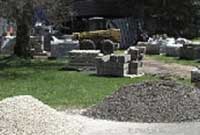
Where will you stage your materials?
Being prepared with the proper tools and equipment before you begin a retaining wall project is important. Here are some other items to consider before you get started:
Site Access
When planning your project, make sure you can access your wall site with construction equipment and materials. For sites with restricted access, plan out where you will stage and store your block, wall rock and other materials.
Wall Rock
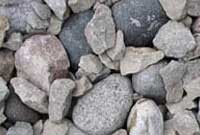
Wall Rock
To build a quality wall, use a clean, granular rock underneath the base course to create a firm foundation for your project.
Good drainage and compaction will add to the quality and performance of your finished wall.
We refer to the material used for the base, within and behind the block as Wall Rock. Crushed or smooth stone, well graded, compactable aggregate, ranging in size from 0.25 in. to 1.5 in. (6 to 38 mm) is the ideal wall rock size. Your AB Dealer will have what you need.
Tools & Equipment You May Need

Have proper tools on hand
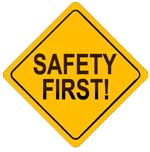
Remember: Safety always comes first.
Hand Tools
Safety glasses, gloves, dust mask, ear protection, knee pads, 4’ level, torpedo level, tape measure, string line, chisel, hand tamper, dead blow hammer, shims, broom, round and square shovel.
Power Tools
Plate compactor, concrete saw with diamond blade, skid loader, transit/site level.
Rental Equipment
Plate compactors, concrete saws, skid loaders and transit levels are very useful when building retaining walls. These are available at most equipment rental centers.
Working with Soils
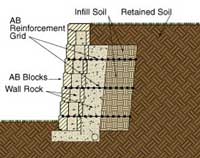
Retaining wall basic building materials
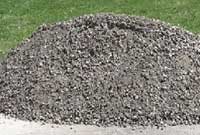
Preferred granular infill material
The soils used below and behind the wall are a critical part of the total wall structure. A reinforced retaining wall contains three basic building materials - the retaining wall blocks, the geogrid reinforcement, and the infill soils surrounding the geogrid layers.
Soils
Understanding the property and characteristics of soils is key to building better walls. Different soil types will dictate the amount of time needed for compaction, the amount of reinforcement required, and potentially the cost of the wall.
Granular soils are better to build with than clay soils. Sand and gravel will compact better, drain better, and often will need less reinforcement. Soils are typically defined by a friction angle or measurement of the internal strength of the soil. This angle is approximately the natural angle of repose. As soil falls off a conveyor to make a pile, the angle it creates represents the natural angle of repose. Check with a qualified geotechnical engineer to obtain an accurate soil classification.
Soil Selection
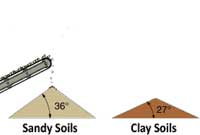
Natural Angle of Repose
If the on-site soils are of a very low quality under or behind the wall, you should remove and replace them with stronger soils. Using stronger soils will reduce reinforcement, allow faster compaction and have better long-term performance. Heavy clays and organic soils are both unsuitable in the reinforced zone and should be removed and replaced. Silty sands and sand with clay will require additional care, and attention to water management when placed and compacted.
Compaction
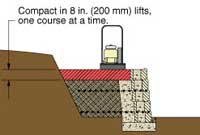
Compact in 8 in. (200 mm) lifts, one course at a time
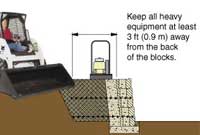
Keep all heavy equipment at least 3 ft. (0.9m) away from the back of the blocks
Proper placement and compaction of the infill soils is critical.
The most important step in getting proper compaction is the placement of the soil in "lifts". Compacting in lifts, or layers, of less than 8 in. (200 mm) will facilitate quality compaction. Placement and compaction in lifts that exceed 8 in. (200 mm) will result in less than adequate soil strength. Compaction equipment must be sized according to the type of material being compacted. Always backfill and compact after each course of block is placed. Consult with a local equipment supplier to ensure that proper compaction equipment is used.
The consolidation zone runs from the back of the block back 3 ft. (0.9 m) into the infill soil. Only walk behind plate compaction equipment is allowed within the consolidation zone. A minimum of two passes with a walk behind plate compactor is required, starting on top of the block and compacting in paths that run parallel with the wall to the back of the excavated area.

